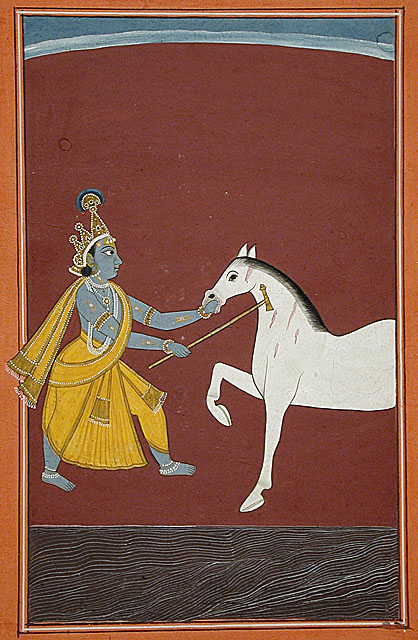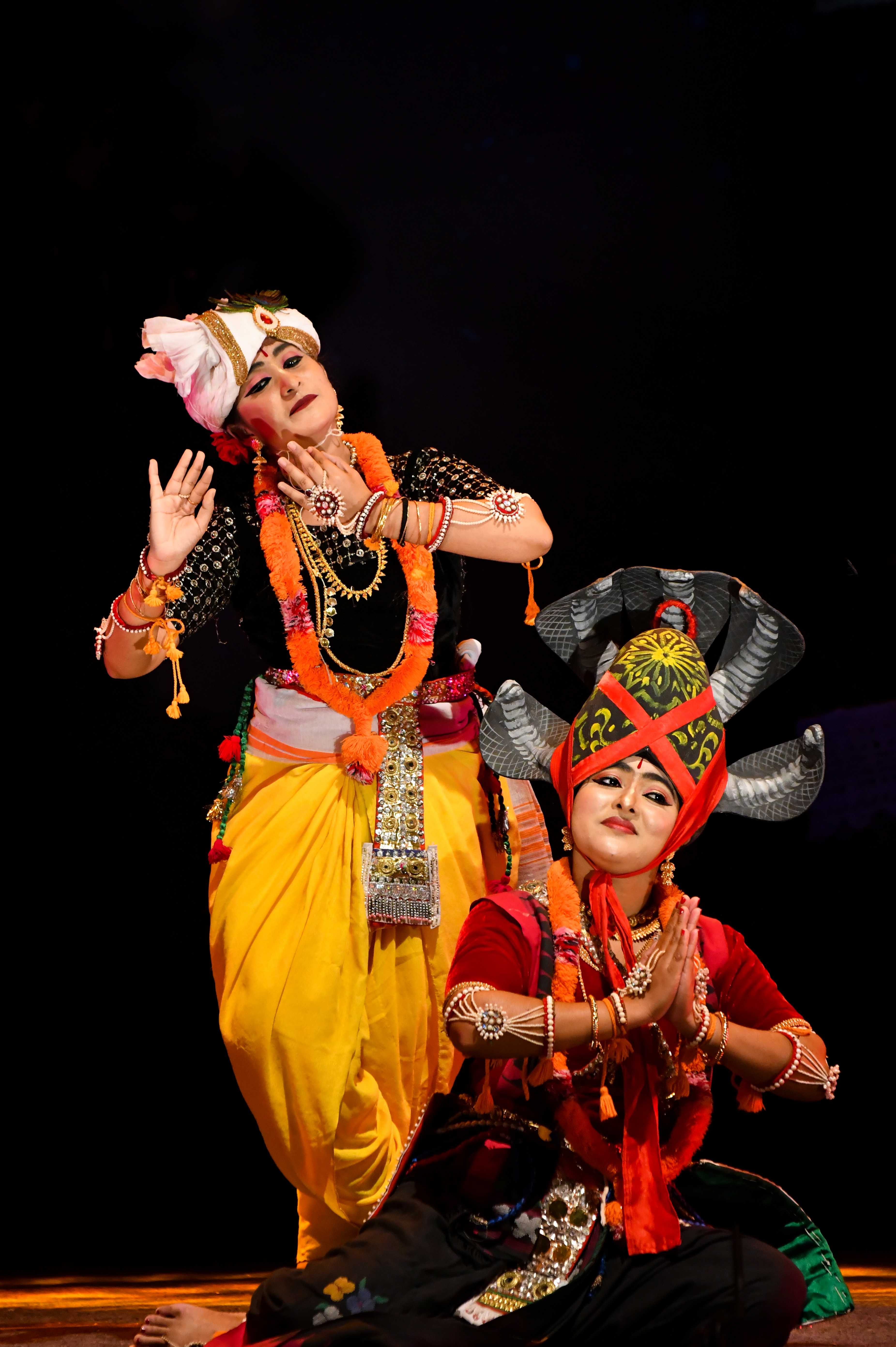|
Dhenuka
In Hindu mythology, Dhenuka, also known as Dhenukasura, is an asura (demon) killed by Balarama, the elder brother of Krishna. The '' Harivamsa'' states that Dhenuka, with his host of attendant demons, all in the form of donkeys, as ruled over a forest of ''tala'' or palms trees, situated on the banks of the Yamuna River, north of mount Govardhana. Once, Balarama, Krishna and cowherds wandered into this forest, captivated by the fragrance of the fruits of the palm trees. When Krishna commented on the possible sweet taste of the fruit, Balarama shook the trees and the fruits fell on the ground. A jealous Dhenuka charged at Balarama, bit him and kicked with his hind legs. Balarama caught hold of Dhenuka's legs and whirled him towards a tree, shattering his chest, neck and waist as the tree fell with the demon. Balarama killed Dhenuka's demon attendants and set the forest open for the cowherds. In Literature The Vishnu Purana also describes his legend: See also *List of Asuras *K ... [...More Info...] [...Related Items...] OR: [Wikipedia] [Google] [Baidu] |
Balarama
Balarama (, ) is a Hindu god, and the elder brother of Krishna. He is particularly significant in the Jagannath tradition, as one of the triad deities. He is also known as Haladhara, Halayudha, Baladeva, Balabhadra, and Sankarshana. The first two epithets associate him with ''hala'' (''langala'', "plough") from his strong associations with farming and farmers, as the deity who used farm equipment as weapons when needed, and the next two refer to his strength. Originally an agricultural deity, Balarama is mostly described as an incarnation of Shesha, the serpent associated with the deity Vishnu while some Vaishnava traditions regard him as the eighth avatar of Vishnu, with Jayadeva’s Gita Govinda (c.1200) "incorporat ngBalarama into the pantheon" as the ninth of the 10 principal avatars of Vishnu. Balarama's significance in Indian culture has ancient roots. His image in artwork is dated to around the start of the common era, and in coins dated to the second-century BCE ... [...More Info...] [...Related Items...] OR: [Wikipedia] [Google] [Baidu] |
List Of Asuras
Asuras () are a class of beings or power-seeking clans, related to the more benevolent devas (also known as ''suras'') in Hinduism. Clans The two major clans of the Asuras are the Daityas and the Danavas. * Daitya - a clan of asuras born from the demonic Diti and Kashyapa. * Dānava - a clan of asuras born from the primordial sea Danu (Known as Dānaveghasā in Buddhism) and Kashyapa. * Rakshasa - a class of beings sometimes categorised as synonymous with asuras Legend * ॐ - mentioned in Hindu scriptures * ☸ - mentioned in Buddhist scriptures A * Āḍi ॐ * Aghāsura ॐ * Ahirāvaṇa - Described as a brother of Rāvaṇa in some versions of the Rāmāyaṇa ॐ * Akṣayakumāra - Son of Rāvaṇa ॐ * Alāmbāsa - A powerful asura mentioned in the Hindu epic Mahābhārata ॐ * Alambuṣa - A powerful asura from the Mahabharata ॐ * Alāyudha - A powerful asura from the Mahabharata ॐ * Andhaka ॐ * Anuhlāda - Son of Hiraṇyakaśipu ॐ * Apasmā ... [...More Info...] [...Related Items...] OR: [Wikipedia] [Google] [Baidu] |
Hindu Mythology
Hindu mythology refers to the collection of myths associated with Hinduism, derived from various Hindu texts and traditions. These myths are found in sacred texts such as the Vedas, the Itihasas (the ''Mahabharata'' and the ''Ramayana''), and the Puranas. They also appear in regional and ethnolinguistic texts, including the Bengali ''Mangal Kavya'' and the Tamil '' Periya Puranam'' and ''Divya Prabandham''. Additionally, Hindu myths are also found in widely translated fables like the ''Panchatantra'' and the '' Hitopadesha'', as well as in Southeast Asian texts influenced by Hindu traditions. Meaning of "myth" Myth is a genre of folklore or theology consisting primarily of narratives that play a fundamental role in a society, such as foundational tales or origin myths. For folklorists, historians, philosophers or theologians this is very different from the use of "myth" simply indicating that something is not true. Instead, the truth value of a myth is not a def ... [...More Info...] [...Related Items...] OR: [Wikipedia] [Google] [Baidu] |
Keshi (demon)
In Hindu mythology, Keshin ( ), also called Keshi ( ) is a horse-demon, killed by Krishna, an Avatara of Vishnu. The demon was dispatched by Krishna's evil uncle Kamsa, who was destined to die at Krishna's hands. The tale of the slaying of Keshi is told in the Hindu scriptures of ''Bhagavata Purana'', ''Vishnu Purana'' and ''Harivamsa''. Krishna is often praised as Keshava - the slayer of Keshi - in scriptures. Legend Keshi's legend is recounted in the tenth Book of the ''Bhagavata Purana'' (between 500 CE - 1000 CE). Kamsa, the evil king of Mathura and the maternal uncle of Krishna, is destined to be killed by Krishna. In an attempt to avoid his death, Kamsa sends a series of demons to Gokula, where Krishna is staying with his foster-parents. After Krishna kills the bull demon Arishta, the divine sage Narada confirms to Kamsa that Krishna is his sister Devaki's child and that the girl-child that Kamsa had killed, mistaking her for the child of Devaki, was in fact the daughter o ... [...More Info...] [...Related Items...] OR: [Wikipedia] [Google] [Baidu] |
Bakasura
Bakasura (, ), also rendered Baka, is a rakshasa featured in the Hindu epic Mahabharata. The rakshasa lives in a forest which nowadays known as "Gangani" located near Garhbeta town of the Indian state of West Bengal. In exchange for protecting the kingdom from invaders, he terrorises its citizens, eating them at will. The weak king is rendered helpless. The people come to an arrangement with their tormentor: They would send him large provisions of food every week, which he would consume, along with the cart-driver who delivered them. In order to save the life of their Brahmin host when it is his turn to deliver the cartload, Bhima is eventually sent out to kill Bakasura, under the direction of his mother, Kunti. The slaying of Bakasura by Bhima is commemorated on the occasion of Bhimana Amavasya. History Pandavas The Pandavas (Sanskrit: पाण्डव, aɳɖɐʋᵊ IAST: Pāṇḍava) is a group name referring to the five legendary brothers, Yudhishtira, Bhi ... [...More Info...] [...Related Items...] OR: [Wikipedia] [Google] [Baidu] |
Kaliya
Kaliya ( IAST: Kāliya, Devanagari: कालिय), in Hindu traditions, was a venomous Nāga living in the Yamunā river, in Vṛndāvana. The water of the Yamunā for four leagues all around him boiled and bubbled with poison. No bird or beast could go near, and only one solitary Kadamba tree grew on the river bank. The celebration of Nāga Nathaiyā or Nāga Nṛitya is associated with the tale of Krishna dancing upon and subduing Kāliya. Legend The story of Krishna and Kāliya is told in the sixteenth chapter of the Tenth Canto of the '' Bhagavata Purana''. The proper home of Kāliya was the island of Ramaṇaka, but he had been driven away from there in fear of Garuḍa, the foe of all serpents. Garuḍa had been cursed by the yogi Saubhari dwelling at Vrindavan so that he could not come to Vrindavan without meeting his death. Therefore, Kāliya chose Vrindavan as his residence, knowing it was the only place where Garuḍa could not come. Once, the sage ... [...More Info...] [...Related Items...] OR: [Wikipedia] [Google] [Baidu] |
Govardhan Hill
Govardhana Hill (; ), also called Mount Govardhana and Giriraj, is a sacred Hindu site in the Mathura district of Uttar Pradesh, India on an 8 km long hill located in the area of Govardhan and Radha Kund, which is about from Vrindavan. It is the sacred centre of Braj and is identified as a natural form of Krishna, the Govardhana Shila. Geography Govardhan Hill, stretching from Radha Kund to south of Govardhan, is a long ridge that, at its highest, stands above the surrounding land. At the southern end of the hill is the village of Punchari, while at the crest stand the villages of Aanyor and Jatipura. The parikarma path of Govardhan hill is intersected by some part of district Deeg of State of Rajasthan. Background Govardhan Hill is considered a sacred site because it is the setting for many legends relating to the life of Lord Krishna, the deity believed to be embodied in the earth of the hill. Krishna and his brother Balarama are said to have spent many ha ... [...More Info...] [...Related Items...] OR: [Wikipedia] [Google] [Baidu] |
Yamuna
The Yamuna (; ) is the second-largest tributary river of the Ganges by discharge and the longest tributary in India. Originating from the Yamunotri Glacier at a height of about on the southwestern slopes of Bandarpunch peaks of the Lower Himalaya in Uttarakhand, it travels and has a drainage system of , 40.2% of the entire Ganges Basin. It merges with the Ganges at Triveni Sangam, Prayagraj, which is a site of the Kumbh Mela, a Hindu festival held every 12 years. Like the Ganges, the Yamuna is highly venerated in Hinduism and worshipped as the goddess Yamuna. In Hinduism, she is believed to be the daughter of the sun god, Surya, and the sister of Yama, the god of death, and so she is also known as Yami. According to popular Hindu legends, bathing in Yamuna's sacred waters frees one from the torments of death. The river crosses several states such as Haryana, Uttar Pradesh, Uttarakhand and Delhi. It also meets several tributaries along the way, including Ton ... [...More Info...] [...Related Items...] OR: [Wikipedia] [Google] [Baidu] |
Rambha (asura)
Rambha is an asura in Hindu mythology. Rambha and Karambha are asura brothers, born as the descendants of Danu and Kashyapa. When they were young, both decided to perform penance to get special powers to establish the rule of Danavas in the universe. Penance and boon According to the Puranas, Rambha and Karambha did Tapas (Indian religions) at Pañcanada for the blessing of having children. Rambha and Karambha meditated upon Mālavaṭa Yakṣa, the former seated at the centre of the five fires and the latter standing in the water of a lake. Indra found out about this, he decided to kill them, first in the guise of a crocodile dragged Karambha away by the feet and killed him by drowning him. Then Indra went after Rambha to kill him but was saved by Agni. Angry at the death of his brother, Rambha decided to cut off his head and offer it as a sacrifice. When he was about to do so, Agni appeared and told him that suicide was worse than killing others, denouncing it as a great sin ... [...More Info...] [...Related Items...] OR: [Wikipedia] [Google] [Baidu] |



